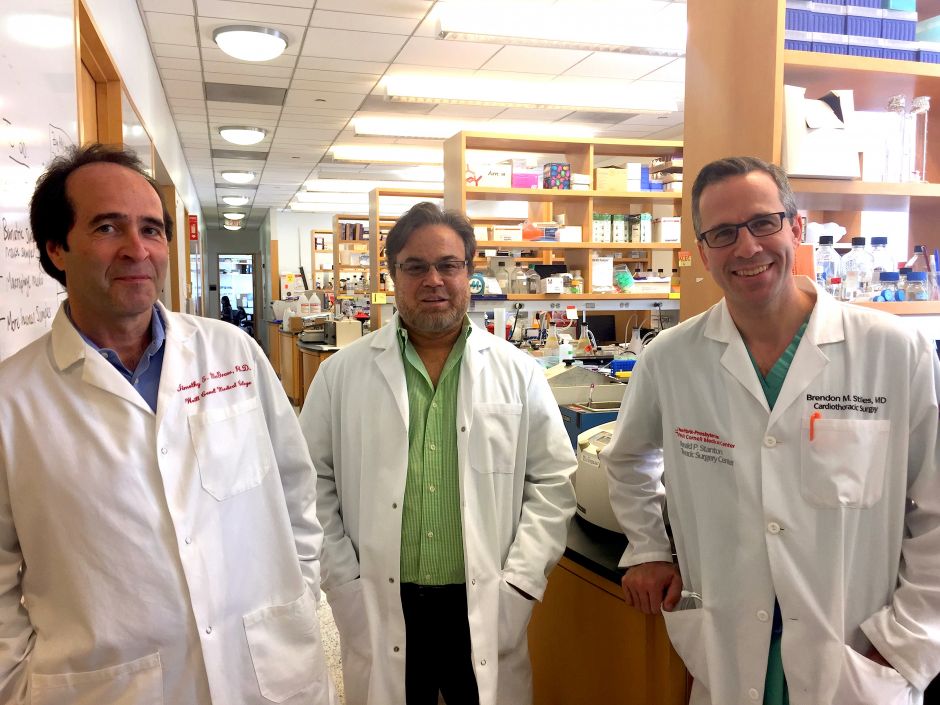Neoadjuvant bevacizumab may improve resection of stage III lung cancer
The addition of bevacizumab to induction chemotherapy appeared associated with high objective response and resectability rates among patients with unresectable stage III lung adenocarcinoma, according to findings from a single-center, single-arm, phase 2 study conducted in China. Brendon Stiles, M.D., was invited by Healio.com/HemOnc Today to contribute his perspective to the study. Read the full article here.
In the study by Ou and colleagues, the researchers describe the results of a phase 2 trial of neoadjuvant therapy in patients with “unresectable” stage IIIA/IIIB lung adenocarcinoma.
The researchers hypothesized that adding bevacizumab (Avastin, Genentech/Roche) to standard chemotherapy (pemetrexed and carboplatin) would increase response rates, improve resectability and potentially prolong survival in this patient cohort.
Despite obvious limitations, I found the study to be quite compelling.
The enrollment criteria, preoperative workup and delivery of neoadjuvant therapy are not what many centers would consider standard. The definition of “unresectable” was not given, although presumably it related to TNM staging. Patients with bulky N2 disease, those with T4N2 disease and those with N3 disease were all included. A PET scan was not obtained in 83% of patients, and a brain MRI was omitted in 14%.
These patients undoubtedly had very advanced disease, some potentially having metastatic disease at presentation. Preoperative radiation therapy, often included in neoadjuvant protocols, was omitted given the lack of safety data with bevacizumab. Further, patients received four cycles of induction chemotherapy rather than the two or three cycles more commonly given.
In the context of those distinctions, the results are nevertheless quite compelling.
Neoadjuvant therapy with bevacizumab was well tolerated with infrequent grade 3 to grade 4 adverse events, limited to fatigue and neutropenia. The objective response rate was a robust 55%, and the percentage of patients who made it to surgery (74%), was similar to modern trials with chemoradiation. For instance in RTOG 0229, 66% of patients underwent surgical resection of their tumors.
The rate of R0 resection was also similar between the current trial and RTOG 0229 (71% vs. 76%), as were rates of N2/N3 downstaging (61.3% vs. 63% mediastinal nodal clearance in RTOG 0229).
Finally, the EFS/PFS rates were similar between the trials, with a reported EFS of 15.4 months in the Ou study vs. a PFS of 12.9 months in RTOG 0229. OS in the Ou study, although not reported, looks to be competitive when compared with the 2-year rates of 54% reported in RTOG 0229 and with the rates reported for various subgroups in RTOG 0617, a trial of definitive chemoradiation for stage III patients with non–small cell lung cancer.
This comes with a note of caution, however, as follow-up was limited to 14.3 months in the Ou study.
So where does this leave us? The most interesting argument to be made is for more trials evaluating novel therapeutics with neoadjuvant chemotherapy for patients with lung cancer and stage III disease.
This is a compelling cohort who, despite being high risk for disease progression, are potentially curable. Many biologic drugs, including targeted therapies and immune checkpoint inhibitors, have been primarily used in the setting of stage IV disease without radiation therapy. As such, toxicity with neoadjuvant chemoradiation trials is a concern.
However, Ou and colleagues have shown — albeit in a small trial — that a biologic can be used in place of radiation therapy and that such patients can safely undergo surgery for local control.
In some instances, such drugs could prove to be competitive financially to radiation therapy and may actually have less toxicity when combined with chemotherapy.
Ou and colleagues demonstrate equivalent rates of downstaging, resection and disease control compared with induction chemoradiation, even in their population that was likely understaged from the beginning.
By “saving” it, radiation therapy could then be used in a directed fashion in the adjuvant setting when appropriate for R1 resections or close margins. Such a strategy may allow for optimization of upfront systemic therapy, as well as for the inclusion of novel therapeutics, potentially increasing cure rates in this challenging cohort of patients.




